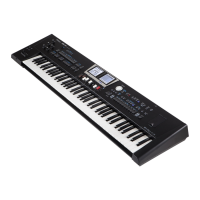Rhythm Track Edit functions
115
Shift Clock
Right Display
“Shift Clock” allows you to shift the notes within the selected
“From”/“To” range. It can be used for two things:
• To correct “slow” notes due to a slow(er) attack. You may want
to use “Shift Clock” after assigning a sound to a track that has
a considerably slower attack than the sound you used for
recording the part in question. This technique is frequently used
in pop music to “time” 1/16-note string arpeggios played with
a “slow” pad sound. Rather than have the notes begin at the
mathematically correct time (e.g. 2-1-0), you could shift them to
the left (e.g. to 1-4-115), so that the peak volume of the attack is
reached on the next beat:
Original positions
(slow attack, timing seems o)
Shift= –5
(timing sounds OK)
• To correct the timing of notes recorded via MIDI without
quantizing them. You can use external sequences as raw
material for your songs. Recording such excerpts via MIDI may
cause a slight delay (e.g. 5 CPT). If that is not acceptable, use
“Shift Clock” to “push” the recorded data to the left (select “–5”).
That allows you to preserve any irregularities the original may
contain because it was not quantized. After selecting a sound
with a slow release (i.e. a sound that lingers on after all notes
have been released), however, “Change Gate Time” will help you
cut the notes down to size and thus avoid undesirable overlaps.
1. Use the dial to edit the following parameters.
Parameter Setting Explanation
Track ADrums~Acc6, ALL
Allows you to select the track you wish
to edit. You can also select “ALL” here,
in which case the operation applies to
all tracks.
Mode Major, Minor, 7th,
Allows you to select the Mode to be
edited.
Division
Intro 1~4, Main 1~4,
Fill Dwn 1~3, Fill Up
1~3, End 1~4
Use this parameter to select the
Division you want to edit.
From Bar
For the settings and explanation see p. 109.
From Beat
From CPT
To Bar
To Beat
To CPT
Data Type For the settings and explanation see p. 110.
Value (CPT) –4800~4800
This parameter sets the amount by
which the notes are shifted. The value
refers to CPT units (one CPT= 1/120 Q).
Notes on the rst beat of the rst bar
cannot be shifted further to the left,
because that would mean shifting them
to the “0” measure, which doesn’t exist.
Parameter Setting Explanation
From Note,
To Note
0 C-~127 G9
• “From Note” allows you to set the
note (or lower limit of the note range)
to be modied within the specied
“From”/“To” time range.
• “To Note” allows you to set the upper
limit of the note range to be modied.
2. Press the [WRITE] button (its indicator ashes) to conrm
your settings and edit the data.
The display briey conrms the operation and then returns to the
current Composer page.
Track Length
This function allows you to modify the length (number of bars,
beats and clocks) of a pattern after recording. Data that lie outside
the range you decided to keep are discarded. Obviously, you only
need to change the settings of the Mode whose length you want
to modify.
NOTE
There is no way to recall the previous version, so be sure to save
your rhythm before continuing. See “Saving your Rhythm” (p.
106).
Right Display
1. Use the dial to edit the following parameters.
Parameter Setting Explanation
Track ADrums~Acc6, ALL
Allows you to select the track you wish
to edit. You can also select “ALL” here,
in which case the operation applies to
all tracks.
Division
Intro 1~4, Main 1~4,
Fill Dwn 1~3, Fill Up
1~3, End 1~4
Use this parameter to select the
Division you want to edit.
Length Bar 000~999
Use the dial to set the length of the
selected pattern(s) in steps of one bar.
You can also make an existing track
longer by specifying a “Bar” value that
lies beyond the last notes.
Length Beat
1~[number of beats
per bar]
Species the beat position.
The number of selectable beats
depends on the selected time
signature.
Length CPT 0~119
This parameter allows you to “ne-tune”
the length. In most cases, you will
probably work with multiples of Q notes
(i.e. 120CPT) because 120CPT represent
one beat of an X/4 bar (1/4, 2/4, 3/4,
4/4, etc.).
Mode
Major, Minor, 7th,
Major+Minor,
Major+7th,
Major+Minor+ 7th,
Minor+7th
Choose the Modes to which the new
length setting should apply.
You can also switch on two or all three
button icons. If you set “Track” to “ALL”,
all three Modes are selected automati-
cally (and that cannot be changed).
2. Press the [WRITE] button (its indicator ashes) to conrm

